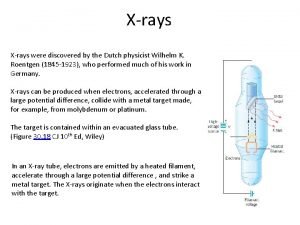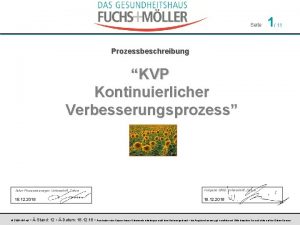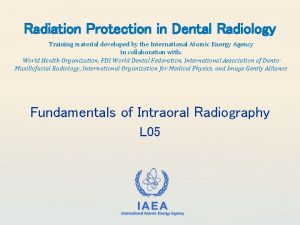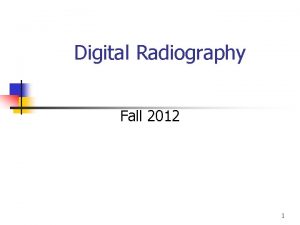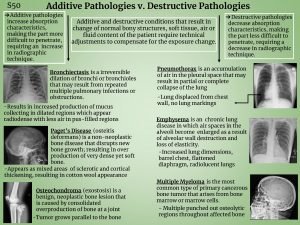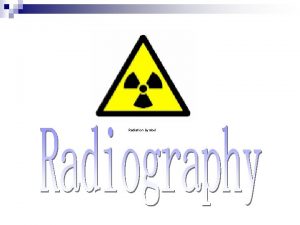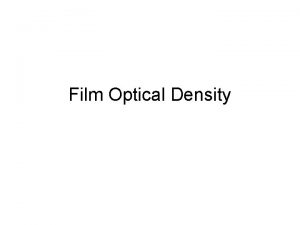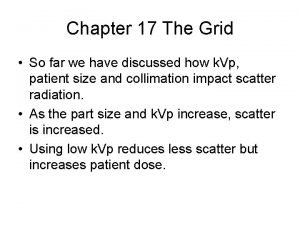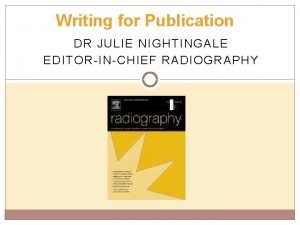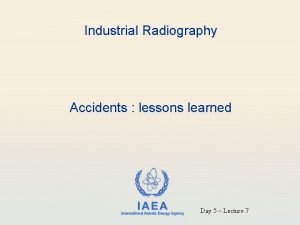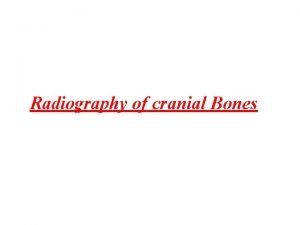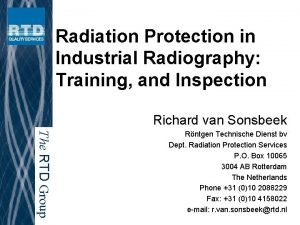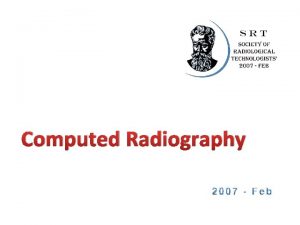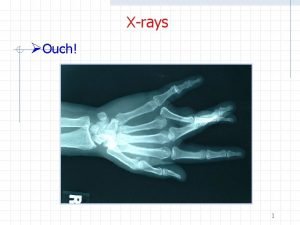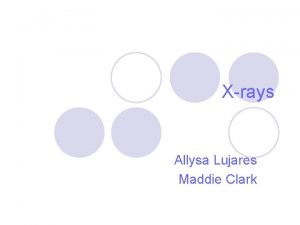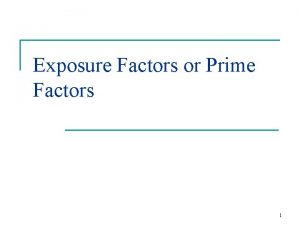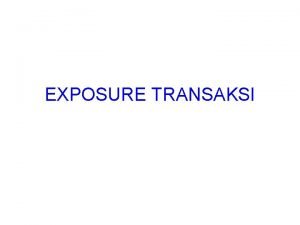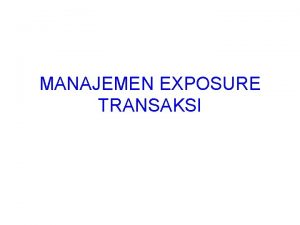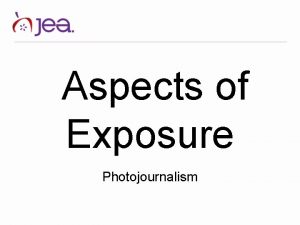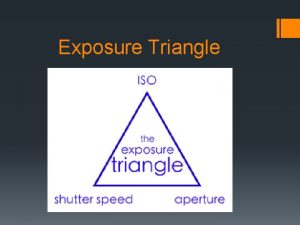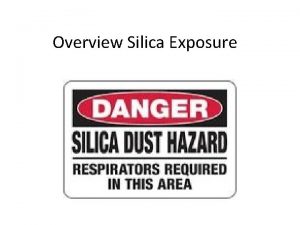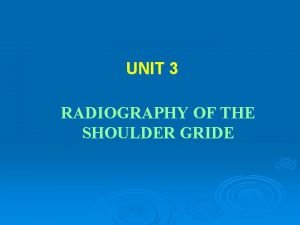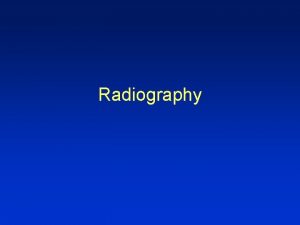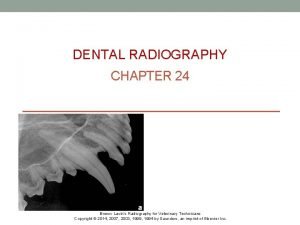Radiography Technique Exposure Factors KVP Energy of xrays
![[Radiography] Technique Exposure Factors [Radiography] Technique Exposure Factors](https://slidetodoc.com/presentation_image/3ed5069e9c666859c2fc0b5876016e5d/image-1.jpg)



































- Slides: 36
![Radiography Technique Exposure Factors [Radiography] Technique Exposure Factors](https://slidetodoc.com/presentation_image/3ed5069e9c666859c2fc0b5876016e5d/image-1.jpg)
[Radiography] Technique Exposure Factors

KVP = Energy of x-rays = higher penetrability, it moves through tissue. The energy determines the QUALITY of xray produced. 1. increase in KVP = electrons gain high energy 2. higher the energy of electrons = greater quality of x-rays 3. greater quality = greater penetrability KVP = QUANTITY = increased k. Vp = more x-rays produced.

MA = tube current = number of electrons and quantity of x-rays produced. MA does not affect quality of x-rays produced. KVP = quality & quantity MA = quantity Time = quantity

Purpose of using Grids 1. ) Increases contrast 2. ) Reduces density 3. ) Must use more MAS with a grid. The choice to use a grid depends on: 1. ) KVP used 2. ) thickness of part Parts 10 cm or larger with a KVP higher than 60 produce enough scatter to necessitate the use of a grid.

Air Gap Technique: This is like a grid. Less scatter on film but less detail also. You can increase SID to help with detail. The greater the gap the less scatter reaches film. 10 inch air gap = 15: 1 grid (small body part 10 cm)

Need proper balance of density and contrast Density = overall blackness Primary controlling factor for density is MAS To make a visible change in density: Requires a minimum 30% change in MAS or double KVP affects density - alters amount and penetrating ability of x-ray beam, so, increasing penetration of x-ray beam results in more radiation – results into more density on x-ray.

^ KVP = ^ quantity of radiation & ^ density Changes in KVp is not equal throughout the ranges of KV (low med. & high) A greater change is required at a higher KVp (greater than 90) compared with a lower KVP (less than 70) KVP affects density and other aspects - so, KVP is not primary factor for changes in density. example: 50 k. Vp increase 10 k. Vp very dark greater change 90 k. Vp increase 10 k. Vp slightly darker smaller change

To maintain density with KVp use the 15% rule: change KVP by 15% and you will have the same effect on density as doubling MAS example: KVP 82 change to 94 (15%) same as MAS 10 change to 20 (double)

Patient thickness In general, for every 4 cm of thickness of patient, you need to adjust MAS by a factor of 2 example: thin pt. 18 cm use 40 MAS thicker pt. 22 cm use 80 MAS to maintain density 40 X 2 = 80 for the additional 4 cm of thickness

KVP (penetrating power) is the controlling factor for contrast. High KV = more densities but fewer differences = low contrast Low KV = fewer densities but greater differences = high contrast KV also affects amount of scatter High KV = increase in scatter - only adds unwanted density (fog) on film. So, increasing fog always decreases contrast. Low KV = decreases scatter - reduces fog, so, increases contrast.

Influencing Factors of Contrast The most influencing factor for contrast is controlling the amount of scatter. less scatter (fog) = increases contrast 1. ) Grids - absorption of scatter that exits patient 2. ) Collimation - wider field = more scatter = less contrast smaller field = reduces scatter = greater contrast 3. ) Air Gap - distance between patient and film this prevents scatter from getting to film. So, when amount of scatter is reduced = higher contrast

4. ) Body Part - composition, thickness, compactness. These differences make the range of densities (contrast) Tissues with higher atomic number absorb more radiation - bone, contrast Tissues with lower atomic number absorb less radiation - air Wide range of tissue composition = high contrast similar types of tissue = low contrast Thicker tissue = more scatter = less contrast

USING A HIGHER KV FOR A THICKER PART ONLY ADDS TO THE INCREASE IN SCATTER. This degrades the quality of film. This creates fog which decreases the contrast. Skinny person - good contrast Heavy person - fog, one density, not a lot of contrast on film

Exposure Modifications: Pediatric chest = use fast exposure times to stop motion. Minimum KVP to Penetrate Chest in Children Premature 50 KV Infant 55 KV Child 60 KV Pediatric patients skull - younger than 6 years old - use 15% less KVP

Adapting exposure factors for children based on exposure factors for adults, excluding chest and skull exams Age Exposure factor adaptation 0 -5 years ; 25% of MAS that is indicated for adults 6 -12 ; 50% of MAS that is indicated for adults

Casts can be made of fiberglass or plaster. Fiberglass generally requires no change in exposure factors. Plaster require an increase in exposure, this depends on whether the cast is still wet or whether it is dry. Dry cast - increase of 2 times the MAS Wet cast - increase of 3 times the MAS

Pathology: If changes are needed to compensate for diseases it is (generally) best to adjust the KVP because this affects the penetrating ability. (minimun of 15% rule) Additive conditions - may need to add KVP Abdomen - aortic aneurysm, ascites, cirrhosis, hypertrophy of some organs (splenomegaly) Chest - atelectasis, congestive heart failure, malignancy, pleural effusion, pneumonia Skeleton - hydrocephalus, metastases, osteochondeoma, Paget's disease (late stage) Etc. - abscess, edema, sclerosis

Destructive conditions - may need to decrease KVP Abdomen - bowel obstruction, free air Chest - emphysema, pneumothorax Skeleton - gout, metastases, multiple myeloma, Paget's disease (early stage) osteoporosis Etc. - atrophy, emaciation, malnutrition

Soft Tissue: Objects in soft tissue: if less density is required - MAS should be decreased Important to know whether contrast should be increased or decreased e. g. airway for soft tissue neck - contrast should be increased Foreign body - decrease contrast to visualize both bone and soft tissue Soft tissues that require a decrease in density should use a decreased MAS Soft tissues that require a higher or lower contrast should use a change in KVP

Variables and their effect on the photographic properties of the x-ray image: Radiographic variables Density Contrast Increase MAS Decrease MAS increase KVP decrease KVP increase SID decrease SID increase OID increase decrease increase decrease no change decrease increase no change increase

Radiographic variables Density decrease OID increase Grid ratio decrease grid ratio increase film-screen increase speed decrease film-screen decrease speed Contrast decrease increase decrease no change

Radiographic variables Density increase collimation decrease collimation increase focal spot no change size decrease focal spot no change size increase central ray decrease angle Contrast increase decrease no change

Using 100 m. A(small focal spot) station for extremity has better detail than Using the same m. As and same k. V with higher ma station Scatter radiation is detrimental to the quality of film and adds unwanted density to the film without adding any patient information. Scatter decreases contrast and using grids increase the contrast. Beam restricting devices and grids are used to limit scatter radiation.

Two major factors that affect the amount of scatter radiation - KVP and the volume of tissue irradiated (opening collimation and larger patient). 1. ) Using higher KVP produce more scatter as compared with a lower KVP. 2. ) Larger field size and the thicker the patient the greater amount of scatter produced from the patient. You should use appropriate KVP and limit x-ray beam to limit scatter.

Beam restriction serves two purposes this increases contrast, also 1. ) limits patients exposure 2. ) reduces scatter Because collimation decreases x-ray field, less scatter is produced within the patient, so, less scatter and contrast increases.

Exposure factors may need to be changed when increasing collimation. (less density) So, as collimation increases (smaller area), density decreases, as collimation decreases (larger area), density increases. When collimating a lot you must increase exposure to compensate for loss of density. The KVP should not be increased because it results in decreased contrast. To change density only, MAS should be changed. It is recommended with a lot of collimation requires an increase in as much as 30% to 50% of the MAS to compensate for the loss of density.

Increases Factor: Effect Collimation - Patient dose decreases scatter decreases contrast increases density decreases Field Size - Patient dose increases scatter increases contrast decreases density increases

Purpose of using grids: 1. ) increases contrast 2. ) reduces density 3. ) must use more MAS with a grid The choice to use a grid depends on: 1. ) KVP used 2. ) thickness of part Grids Improve contrast, using a grid requires additional MAS resulting in a higher patient dose. Grids are typically used only when the patient part is 10 cm (adult knee size)or greater and when using more than 60 KVP.

Air gap technique: This is like using a grid. Less scatter on film but also less detail. You can increase SID to help with the detail. The greater the gap the less scatter. Using an increases OID is necessary for the air gap tech. However, this decreases quality. To decrease unsharpness and increase detail, you must increase SID.

Accurate measurement of part thickness is critical to the effective use of exposure technique charts. Two types of technique charts: 1. ) Variable KVP/fixed MAS 2. ) Fixed KVP/variable MAS 1. ) Variable KVP/fixed MAS: (Best with small extremities) KVP increases as part size increases. Baseline KVP is increased by 2 for every 1 cm increase in part thickness, and MAS stays the same.

Accurate measurement of part thickness is critical to use this type of chart. In general changing the KVP for variations in part thickness is ineffective throughout the entire range of x-rays. This kind of chart is most effective with small extremities such as hands and feet. At low KVP levels, small changes in KVP may be more effective than changing the MAS. Contrast will vary and these types of charts tend to be less accurate for part size extremes. Adequate penetration of the part is not assured, and the x-ray produced with the use of this type of chart tend to have higher contrast

2. ) Fixed KVP/variable MAS This uses an Optimal KVP which is the KVP value that is high enough to ensure penetration of the part but not too high to diminish x-ray contrast. Then the MAS is varied to the part thickness. In general, for every 4 -5 cm change in part thickness, the MAS should be adjusted by a factor of 2. (double MAS)

Accurate measurement of part thickness is important but less critical compared with variable KVP. An advantage of using this chart is that patient groups can be formed around 4 -5 cm changes. You can use patient thickness groups. It is easier to use, more consistency on films, standardization of contrast.

(15% rule) 100 KV up to 115 KV = doubling MAS To make a visible change in density it requires at least 30% change in MAS or 50%. Changes in KV differ at high and low levels. greater change is needed with 90 KV compared to 50 KV 90 KV and increase 10 KVP = slightly darker 50 KV and increase 10 KVP = very dark

To maintain density with KVP use 15% rule so 15% increase in KVP = doubling MAS maintains density KVP 82 change to 94 (15%) is same as MAS 10 change to 20 (double) For each additional 4 cm thickness you need to double MAS to maintain density.

15% rule 60 = 69 62 =71. 3 65 = 74. 75 68 = 78. 2 70 = 80. 5 72 = 82. 8 75 = 86. 25
 Variable kvp technique chart
Variable kvp technique chart Frcr physics lectures
Frcr physics lectures Gamma ray
Gamma ray Jfk jr plane crash photos
Jfk jr plane crash photos Wilhelm k roentgen
Wilhelm k roentgen Managing economic exposure and translation exposure
Managing economic exposure and translation exposure Translation exposure
Translation exposure Balance sheet hedge translation exposure
Balance sheet hedge translation exposure Managing economic exposure and translation exposure
Managing economic exposure and translation exposure Kvp prozess vorlage
Kvp prozess vorlage Kvp präsentation
Kvp präsentation Www.kiinteistoasiat.fi
Www.kiinteistoasiat.fi Energy energy transfer and general energy analysis
Energy energy transfer and general energy analysis Energy energy transfer and general energy analysis
Energy energy transfer and general energy analysis Focal trough in panoramic radiography
Focal trough in panoramic radiography Grid conversion formula
Grid conversion formula Common causes of faulty radiographs
Common causes of faulty radiographs Latent image formation
Latent image formation Infection control in dental radiology ppt
Infection control in dental radiology ppt Filmless radiography
Filmless radiography Radiographic film
Radiographic film Computed radiography cassette
Computed radiography cassette Additive and destructive pathology
Additive and destructive pathology Radiography safety precautions
Radiography safety precautions Darkroom entrance
Darkroom entrance Radiography cordon off distance formula
Radiography cordon off distance formula Optical density in radiography
Optical density in radiography Grid cut off
Grid cut off Gurney-mott theory radiography
Gurney-mott theory radiography Soot and whitewash radiography
Soot and whitewash radiography Industrial radiography accidents
Industrial radiography accidents Radiography
Radiography Standard occlusal radiograph
Standard occlusal radiograph Industrial radiography accidents
Industrial radiography accidents Rni radiography
Rni radiography Crista gali
Crista gali Industrial radiography training
Industrial radiography training




